IP protection degree: decoding of the standards
Under certain conditions, any electrical devices can become a source of danger.To avoid this, markings are applied to the case or packaging indicating the degree of protection IP - this is a combination of letters and numbers containing comprehensive information about the operating conditions of the devices.
Agree, the ability to read these markers is especially important when choosing equipment and devices used in difficult conditions: high humidity, dust formation, risk of mechanical stress, etc. We will tell you how to find out information, decipher the markings and select the right device in this article.
The content of the article:
IP for electrical devices
The abbreviation IP, accepted throughout the world, has several possible decoding options: International Protection Marking/international security code, Internal Protection/internal protection, Ingress Protection Rating/degree of protection against interference.
The marking indicates the level of protection of a technical device from dust, solid objects, and water.
The data that characterizes the class of the device is determined experimentally using specially developed verification methods.
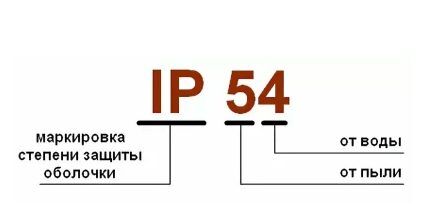
To determine the IP level, the international standard EC60529 is used, the analogue of which is GOST 14254-96, as well as the complicated German version DIN 40050-9.
On the territory of Russia, any equipment installed indoors must comply with PEU - rules for electrical installations, technical conditions - TU, GOST R51330.20-99.
According to the accepted Russian and international classification, the maximum level of protection is marked with the IP68 code.
This designation indicates that the device is completely dust-proof, which can also remain in water for a long time, experiencing significant pressure.

The highest degree of protection provided by the DIN system is marked as IP69-K; Such marks are applied to products that can withstand high-pressure hot water washing.
You can find devices that have an undetermined degree of protection. In this case, the digital designation is replaced by the letter “X”, that is, the marking will look like “IPX0”. This designation may also be followed by one or two Latin letters.
Decoding the numbers on product labeling
Electrical devices may contain different values on the case or in the passport/technical documentation, indicating the safety of their use in certain conditions. Below we will look in detail at what each of these indicators means.
The first digit on the device
The first number indicates protection against solid objects.

The designation scale includes indicators from 0 to 6:
- «0“—suggests a complete absence of a protective barrier.Dangerous components of a device with such markings are essentially freely available;
- «1» - indicates certain restrictions for the intervention of a solid object whose size exceeds 50 mm, for example, such a device cannot be penetrated with the back of the hand;
- «2» - indicates the presence of an obstacle for objects whose size exceeds 12.5 mm, which corresponds to a finger;
- «3“- indicates the impossibility of getting inside the device using plumbing tools or objects with a diameter of more than 2.5 mm;
- «4» — guarantees the protection of equipment from the ingress of any solid particles with a parameter >1 mm;
- «5» - indicates partial dust protection;
- «6"—the highest level of protection; The device body reliably protects the internal mechanism from the smallest elements scattered in the air.
Marking 4-6 indicates the impossibility of reaching live parts of the device using a needle, pin, or thin wire.
Second digit of marking
The next digit of a two-digit number is no less important than the previous one. Markings are indicated by numbers ranging from 0 to 8.
The possibility of using equipment in a room containing water vapor depends on it.
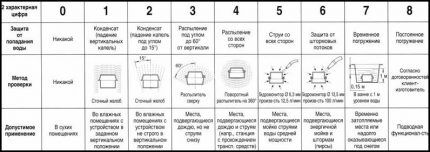
As in the previous case, “zero” indicates the absence of any protection, essentially open contacts.
Equipment marked with this sign may only be used in completely dry rooms that are well heated in winter.
Explanation of values:
- «1“—involves protecting the mechanism from water drops falling vertically onto the shell of the device; without getting inside where the live parts are located, moisture drains from the surface;
- «2» — the housing prevents the penetration of water drops falling at an angle of 15°;
- «3» - a barrier to water droplets flowing at an angle of 60°;
- «4“—electrical devices with this indicator can be placed under the open sky, since the casing protects the mechanism from light rain and splashes;
- «5»—the shell can withstand weak streams of water, so they cannot get inside;
- «6» — protection against high-power water jets;
- «7» - a device of this class can be immersed under water for a short time;
- «8"—the maximum level of protection; for devices with this marking, stable operation under water is available for a long period.
Options for combining numbers with letters are possible, but not required.
Letter designations of protection class
According to the standards adopted in GOST 14254-96, the designations may additionally use letters that are placed after the numbers. To determine the degree of IP protection, you need to be able to read the marking, i.e., decipher it.
Decoding the first letter
The symbol immediately after the numbers indicates access parameters to the internal electrical equipment.
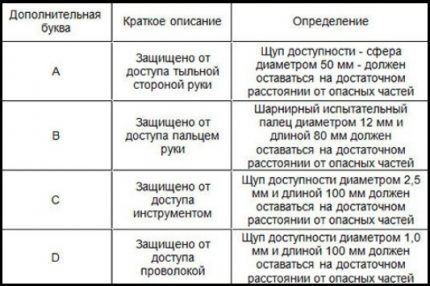
The first letter character after a two-digit number has the following meaning:
- A — the body of such devices creates an obstacle to the penetration of large objects; Live parts of the device must not be touched with the palm of your hand;
- IN — the shell of the device prevents the user from touching live elements with his finger;
- WITH — reliable protection makes it impossible for conductors to come into contact with a screwdriver, wrench and other tools;
- D — a perfectly fitted casing prevents access to the device by a needle or thin wire.
As an example, consider the IP20B marking. The device on which it is applied does not have any protection against moisture; It cannot be penetrated by objects whose thickness is more than 12.5 mm.
What does the second letter say?
The following letter symbol used in the marking indicates the ability of electrical equipment to operate under special conditions.
The following Latin letters are used in marking:
- H — a high-voltage device that can withstand voltages up to 72 kV;
- M — the device is able to withstand high humidity while on the move;
- S — moisture does not enter fixedly located electrical equipment;
- W — the device has additional safety equipment that guarantees absolute protection from climatic factors: dew, wind, snow, hail, rain, frost.
It is worth noting that the current GOST has abolished the “W” designation, but it may be present in the markings of age-related equipment
Extended German standard
There is also the DIN 40050-9 standard adopted in Germany, which provides an increased level of protection IP69K, which indicates the possibility of high-temperature washing.
Appliances marked with this marking are not only completely dustproof, but also withstand extreme combinations of hot water and high pressure.
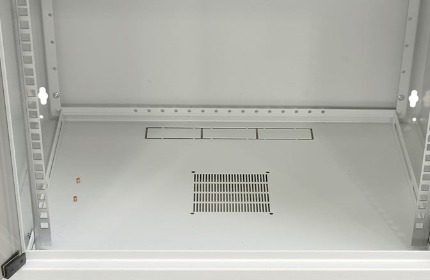
Initially, this level of protection was used to mark special vehicles - concrete mixers, trucks, sprinklers, which require regular intensive washing.
Later, the updated format found application at enterprises in the food and chemical industries, as well as in other areas of the national economy.
Common markings for electrical appliances
Since modern electrical devices are used in a wide variety of conditions, equipment of different classes of protection against moisture and solid particles has become widespread in everyday life and production.
The most popular markings include codes IP20, IP44, IP65, IP30, IP54.
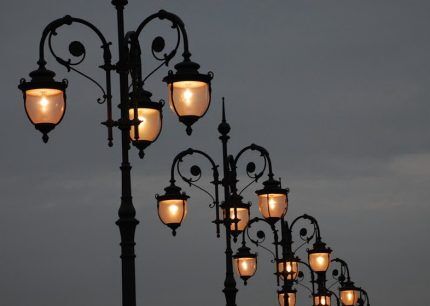
The IP20 protection level indicates that the device body protects against the ingress of objects with a diameter of over 12.5 mm, but does not prevent the ingress of moisture at all.
Devices marked with this marking are recommended to be installed in houses with dry air and good heating.
Such equipment requires careful handling: a not too high degree of protection against the penetration of solid objects contributes to mechanical damage.
The IP30 marking indicates no protection from moisture, but such a device better protects devices by preventing the interference of dense objects with a diameter of 2.5 mm or more.
The hard shell of IP44 class products reliably prevents the internal mechanism from getting in contact with conductors, nuts, and hand tools whose size exceeds 1 mm.
At the same time, the casing guarantees protection against water vapor and splashes falling at a 60-degree angle.

Equipment with IP44 level is suitable for installation in wet rooms and outdoors. In the latter case, it is better to place it under a canopy to protect it from rain.
Devices of this class can also be installed in industrial premises and workshops, with the exception of places where piles of dust accumulate.
Devices of IP54 class differ from those described above in that they are completely protected from interference from solid objects and have partial dust protection.
They can be installed both inside and outside. However, when installing outdoors, it is advisable to consider additional shelters from precipitation.
The IP55-rated equipment case provides excellent protection against moisture and also protects against dust. Devices of this level are suitable for wet rooms; they can be installed outdoors, where they can withstand even short rains.

Products marked IP65 are completely dustproof. They can be installed almost anywhere: in production facilities, workshops, warehouses or other dusty spaces.
Such devices are also ideal for installation in basements or cellars, which are characterized by a combination of high humidity and dust.
Electrical safety in the bathroom: IP class
A high degree of security is especially important for devices that have to operate in difficult conditions.
Such rooms in the house include the bathroom, the air of which contains a high percentage of water vapor.
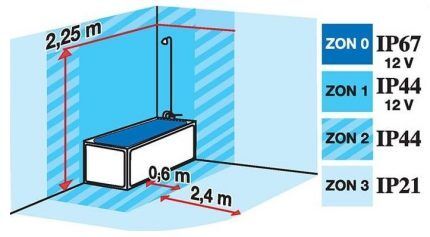
Before equipping this room, a plan for the placement of electrical appliances should be developed in advance, taking into account their distance from sources of moisture.
The highest, almost 100 percent, degree of humidity is observed directly next to the shower or bath. In this area, it is required to use low-voltage luminaires with the highest protection levels IP67 or IP68.
The area above the font or shower stall is also considered quite dangerous: splashes and steam enter here in large quantities. Devices marked IP45 are suitable for installation.
If the lamp is planned to be mounted in the center of the room at some distance from sources of moisture, it is enough to choose an option with class IP24 or higher.
For the driest part of the bathroom, a product marked IP22 is recommended. Some degree of protection must be provided due to the background moisture content of the room and the possibility of steam release.
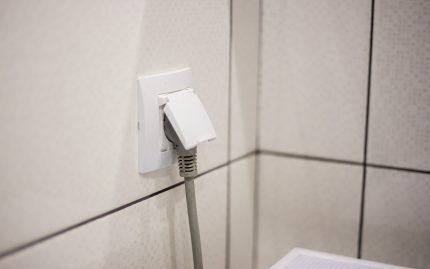
When selecting waterproof socket It is better to give preference to one with a moisture protection class in the range of 4-6. If it is intended to be placed away from the shower or font, marking 4 is sufficient.
At a closer location with possible splashes, the level of protection should be higher - 5 or 6.
To equip a bathhouse or sauna with lamps and/or other electrical appliances, you need to choose electrical accessories of class IP54 and higher.
Additional information on arranging a bathroom is presented in the articles:
- How to choose bathroom fixtures: which one is better and why? Comparative review
- Installing sockets in the bathroom: safety standards + installation instructions
Conclusions and useful video on the topic
The video will help you understand the degree of IP protection, which is discussed using the example of various electrical appliances:
Using a device with an inadequate level of protection can lead to serious consequences: failure of the device, short circuit of the electrical wiring, and even electric shock.
To avoid such troubles, when selecting one, one must certainly take into account the conditions in which he will have to work. Before purchasing, you need to check the labeling, which must fully comply with the requirements.
Do you have anything to add, or do you have questions about marking and deciphering the degree of IP protection? You can leave comments on the publication, participate in discussions and share your own experience in choosing electrical appliances. The contact form is located in the lower block.




